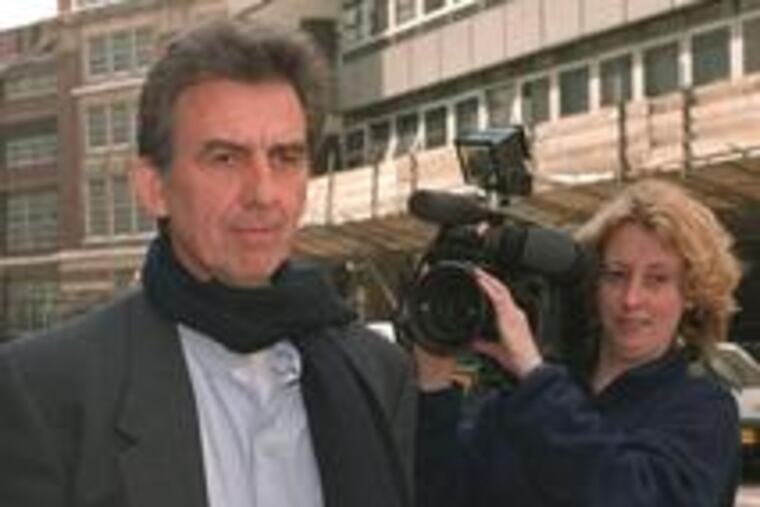Dead rock stars, alive on coffee tables
LOS ANGELES - Deborah Chesher was going through her old boxes of negatives one day when a thought crossed the photographer's mind about how young and alive all of the guitar gods of her youth had been.

LOS ANGELES - Deborah Chesher was going through her old boxes of negatives one day when a thought crossed the photographer's mind about how young and alive all of the guitar gods of her youth had been.
It was quickly followed by the realization that many of those rockers were also dead, and most had died young.
She has now brought those synaptic occurrences into focus in the coffee-table book
Everybody I Shot Is Dead
. The 208-page volume, with photos in black-and-white and color, celebrates the joyous, often unguarded, moments of some of rock music's biggest stars.
The book also chronicles some of the legendary excesses that led such stars as Harry Nilsson, the Beach Boys' Dennis Wilson, T. Rex's Marc Bolan, and scores of others to their early exits. Chesher, however, chooses to downplay that element.
"It's truly not about dead people as much as it is about how amazing these musicians were," Chesher says as she sips a latte during a recent interview at a friend's art studio.
"The theme is resurrection. I'm bringing them back to life with pictures that have never been seen before and that were taken at a time when they were all extremely vibrant and productive - which is how I like to remember them."
As much a fan as a photographer when she started, the native Canadian arrived in Los Angeles in the mid-1970s with a 35mm camera and a portfolio of touring rock acts she had photographed as they passed through Vancouver. She was soon working at all the local music haunts, shooting musicians for albums, concert posters and publicity photos.
Although some typical "rock star as deity" poses make it into
Everybody I Shot
, most of the 48 people profiled in its pages are captured in a way that reflects more of a human side. There is a joyous George Harrison on stage in embroidered jeans and bright yellow shirt, and a relaxed Maurice Gibb of the Bee Gees visiting backstage with family and friends.
Little Feat's Lowell George is playfully making bunny ears behind record executive Mo Ostin's head as Ostin reviews a contract the two are about to sign. Michael Bloomfield even takes his turn behind the camera, producing some blurry black-and-white images in an apparently misguided attempt at art photography.
Not all that long after he took those photos, the guitarist died of a drug overdose at age 37. It was a tragedy that still brings Chesher to tears.
Others, such as George, who was 34 when he suffered a fatal heart attack, died young after years of hard living. Still others, like Bolan, who was 29, perished in car crashes or, in the case of former teen idol Rick Nelson, plane crashes.
But not everyone was a victim of life on the road. Some, like Papa John Creach, the old man of the Jefferson Airplane, lived well into his 70s. And, Chesher acknowledges, not everybody she shot is actually dead.
"Maybe I'll do an
Everybody I Shot Is Alive
book next," jokes the photographer, an exuberant woman whose long blond hair cascades past her shoulders. She looks much the same as she did in photos from the 1970s, dressed casually in jeans, black sneakers, and a black-and-white pullover shirt.
The fellow survivors she photographed include Van Morrison, Steve Miller, Joni Mitchell, Ron Wood, Tom Waits, all the members of the Eagles, and Crosby, Stills, Nash and Young. That's not to mention seemingly indestructible rock-and-roll pioneer Chuck Berry, who is 81.
But there is clearly a greater fascination with chronicling the lives of those who lived fast and died young, said Josh Kun, a professor of English at the University of Southern California and the director of USC's Popular Music Project.
"Books like this are tapping into a collective desire for remembering an era of rock-and-roll that, whether it's true or not, felt more pure, felt more authentic, more aggressive in its stance against the status quo," Kun said.
As such, he said, books like
Everybody I Shot Is Dead
have an appeal not just to aging baby boomers but also to young music fans who will download everything they can find on the Web on legendary groups like Led Zeppelin.
"You can't talk about Britney Spears, or even a band in the indie world like Arcade Fire, with the same kind of iconicity," Kun said.
It's that iconic standing in pop culture, he said, that keeps people hungering for photos and stories about such Chesher subjects as John Bonham, the Zeppelin drummer who was 32 when he died in his sleep, reportedly choking to death after a night of heavy drinking.
There's also a magical hold that music and the people who make it have on people.
Photos of rock stars in their prime, particularly candid shots, give fans a way of connecting with musicians that goes beyond sitting in the audience at a show, Kun said.
Chesher, who has moved on to film work but still takes the occasional band photo, hopes the book won't so much glorify rock's excesses as inspire the younger musicians she meets by showing them another side of their heroes. Her previous book, 1979's
Starart
, collected photos of musicians' artworks.
"The amount of amazing music they put out in that period of time - they just don't do that anymore," she says.